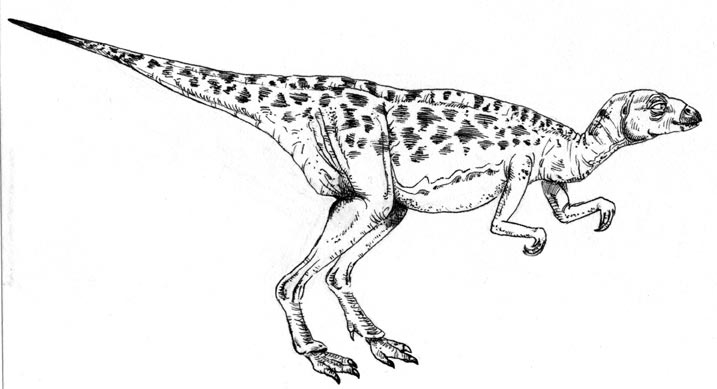Partial Hypsilophodontid Skeleton from Victoria Described.
A team of palaeontologists working on the rugged coastline of Victoria state have uncovered the first partial skeleton of a dinosaur, the first such find in the area for nearly 20 years. The team led by scientists from the Museum Victoria and Monash University have published their findings on a small plant-eating dinosaur found near Cape Otway
This small dinosaur, known as a hypsilophodontid, part of the ornithopod group, probably stood about a metre tall and would have been a fast runner. The rocks the fossil was found in date from approximately 106 million years ago (Lower Cretaceous – Albian faunal stage).
A Typical Hypsilophodontid Dinosaur Drawing
It is only the third partial skeleton of a dinosaur ever found in Victoria. The first two – of similar dinosaurs – were found about 20 kilometres away at the famous site known as Dinosaur Cove. Since then, only isolated dinosaur bones and teeth have been found in Victoria.
To view models of Australian dinosaurs and other prehistoric animals: CollectA Prehistoric Life Models and Replicas.
Research leader and Museum Victoria vertebrate palaeontologist Tom Rich, who with his wife Professor Patricia Vickers-Rich of Monash has led and funded the dinosaur operations in Victoria since 1978, have named and described a number of hypsilophodontids including Leaellynasaura and Qantassaurus
The latest discovery, from a sandstone shore platform, was first uncovered by the research team in November 2005, but details had not been publicly reported.
Exciting Fossil Discovery
The fossils reveal the rear half of the dinosaur’s spinal column, including the tail and a foot. Unfortunately, the front half of the fossil had already been washed away by the sea. However, tests carried out in the area reveals that this was probably a prehistoric log jam caused as rivers in flood gathered materials in a certain spot. This may mean that other fossils and evidence from the Cretaceous will have been preserved at this site, so there might be more dinosaur remains waiting to be discovered.
Around 106 million years ago this part of Australia was located approximately 75 degrees south, these little hypsilophodontids would have inhabited a polar forest, enduring freezing temperatures in the long Southern Hemisphere winter and survived in total darkness for 3-4 months of the year as the sun remained below the horizon.
One of the peculiarities about this group of little dinosaurs, is how they got their names. Leaellynasaura was named after Tom Rich and Professor Patricia Vickers-Riches’ daughter. Fair enough, but due to the sponsorship of the dig site and the support required from commercial organisations for the researchers to actually extract the fossils, some dinosaurs have ended up with strange names. For example, Qantassaurus is named after the Australian national airline, an important sponsor, and the small hypsilophodontid Atlascopcosaurus was named after Atlas Copco, another company that helped fund the dig and supplied important equipment.
The Famous Dinosaur Cove
An articulated partial skeleton of an Atlascopcosaurus found at the Dinosaur Cove mine provides an insight into the lives of these little dinosaurs. The left tibia (the shin bone) shows signs of an acute infection of the bone (osteomyelitis). Such a condition would have made this animal incapable of moving very far and would have effectively crippled it. However, this Atlascopcosaurus lived for many years with this painful condition. Scientists have speculated that this animal may have been part of a small family group and it was its clan members that looked after it. Also, this fossil evidence may indicate that these animals were year-round residents of the polar forests and did not migrate backwards and forwards following the sun, as some scientists have postulated. This Atlascopcosaurus would not have been capable of making such a long journey. Finally, the crippled Atlascopcosaurus may indicate that there were few predators around, as such a severe handicap would have made this little dinosaur an easy meal for any passing theropod.







Leave A Comment